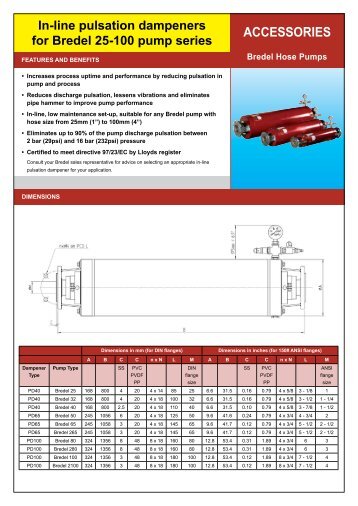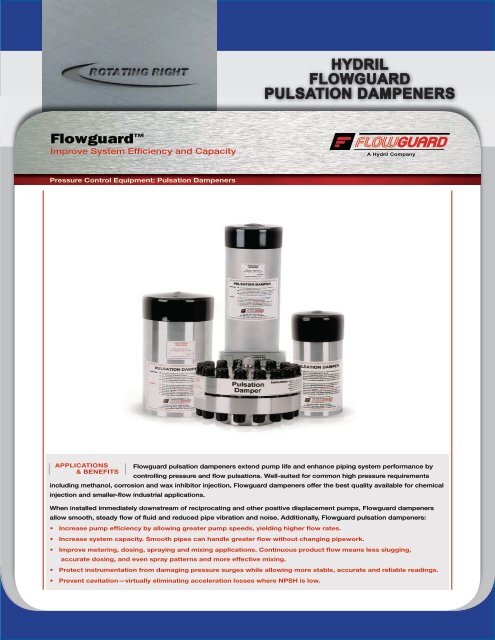SFU Series
PULSATION DAMPENERS. Urethane Bladder. EMSCO PD - 43/45. EMSCO PD - 53/55. KB45 same as PD - 43/45. KB75 same as PD - 53/55. Pulsation Bladder. Hydril K-10 (same as Sumlar) P/N #41586. Hydril K-20 (same as GP Matco) P/N #35504. EMSCO PD - 43/45 (12 gallon) P/N #6922-0086-00. EMSCO PD - 53/55 (20 gallon) P/N #6922-003-00. Sizing Pulsation Dampeners Is Critical to Effectiveness Pressure variation is an important consideration when determining the appropriate size pulsation dampener needed for an application. By David McComb, Blacoh Fluid Control Pumps & Systems, April 2014 Positive displacement pumps effectively pump fluid at a constant average flow rate. Hydril retains for itself all propriety rights in and to all designs, engineering details, data, and procedures set forth herein. This manuals is intended for the sole use of Hydril customers, and they shall strictly control copying of same, as this manual and all copies thereof may be recalled by Hydril at any time. OPERATOR’S MANUAL K80-3705 Pulsation Dampener PAGE 2 Pressure Control Equipment SALES HEADQUARTERS: P.O. Box 60458, Houston, Texas 77205. Telephone: (281) 449-2000. HYDRIL CSD HOU. FAX: (281) 985-2828.

- SFU o-ring
- SFU wing nut
- Dust cap
- Loading valve
- Bleeder valve
- Cartridge
- Case
SFV & SFVM Series
- 6″ or 8″ suction gasket
- 6″ or 8″ grooved coupling
- Dust cap
- Loading valve
- Bleeder valve
- Cartridge
- Case
Hydril Pulsation Dampener Manual Hydraulic
SFT Series
- HPG-1 gasket (Nitrile or EPDM)
- Dust cap
- Loading valve
- Bleeder valve
- Cartridge
- Case
SFM Series
- SFM o-rings (2 required)
- SFM wingnut
- Dust cap
- Loading valve
- Bleeder valve
- Cartridge
- Case
- SFM wingnut screw
CHARGE TO 80%- 90% OF SUCTION PRESSURE OR THE MAXIMUM CHARGE PRESSURE OF THE CARTRIDGE, WHICHEVER IS LESS. THIS IS ONLY AN APPROXIMATION.
(YOU MAY FIND IT NECESSARY TO DECREASE THE PRESSURE IN THE SUCTION CARTRIDGE TO ACHIEVE OPTIMUM PUMP PERFORMANCE.)
- Shut down pump and relieve line pressure from discharge side before closing suction valve. After discharge line is relieved of pressure, close suction line valve and drain suction line.
- Open bleeder valve ’A’.
- Remove loading valve protector cap ’B’.
- Remove cap from loading valve ’C’.
- Loosen safety nut ’D’ three full turns.
- Using NITROGEN ONLY, charge the cartridge through loading valve ’C’ to the recommended operating pressure (90% of suction pressure). (DO NOT EXCEED MAXIMUM CARTRIDGE CHARGE PRESSURE).
- Tighten safety nut ’D’ on loading valve ’C’.
- Replace loading valve protector cap ’B’
- Open suction valve. When air from bleeder valve ’A’ is evacuated, close bleeder valve ’A’.
- Shut down pump and relieve line pressure.
- Open bleeder valve ’A’.
- Remove loading valve protector cap ’B’.
- Remove cap from loading valve ’C’.
- Loosen safety nut ’D’ three full turns.
- Using NITROGEN ONLY charge the cartridge through loading valve ’C’ to correct charge pressure (use chart below).
NOTE: DO NOT EXCEED MAXIMUM CARTRIDGE CHARGE PRESSURE (ON CASE LABEL). - Tighten safety nut ’D’ on loading valve ’C’ and replace cap.
- Replace loading valve protector cap ’B’.
- Open suction valve. When air from bleeder valve ’A’ is evacuated, close bleeder valve ’A’.


WARNING
THE USE OF ANY GAS OTHER THAN NITROGEN IS EXTREMELY DANGEROUS.
Hydril Pulsation Distributor
NEVER ATTEMPT TO CHARGE OR PRE-CHARGE A CARTRIDGE OUTSIDE OF THE PULSATION STABILIZER CASE.
Hydril K20 Pulsation Dampener Manual

Hydril Pulsation Dampener Manual Transmission
FOR PROPER CHARGING PROCEDURES REFER TO THE SUCTION OR DISCHARGE CHARGING GUIDE.